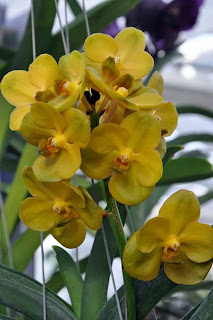Moon Orchid
>> Tuesday, January 17, 2012
Description
Scientific Names: Phalaenopsis amabilis
Common Names: Moon Orchid, Moth Orchid, Butterfly Plant, Anggrek Bulan (Indonesia)
Plant Type: Small-size vines flower.
Height: 12-18 inch (30-45 cm). Flowers can grow up to 10cm even more.
Native Habitat: Grow in warm conditions. Way of life with a stick in epiphyte on trunk or branches of trees in rainforest and lives up to 600 meters above sea level. Can also be maintained in a pot in medium fir bark and keep in partial shade. Water about once a week. Keep plant fairly moist but not wet.
Native Range: This species is usually found in the eastern to the Southeastern regions of Asia. Plants in this genus are typically widespread in the areas of Indonesia, Malaysia, Philippines, Papua, up to Australia.
Conservation Status: This plant in Indonesia is categorized as a protected plant. This is done as an effort to maintain the viability of this plant.
Scientific Names: Phalaenopsis amabilis
Common Names: Moon Orchid, Moth Orchid, Butterfly Plant, Anggrek Bulan (Indonesia)
Plant Type: Small-size vines flower.
Height: 12-18 inch (30-45 cm). Flowers can grow up to 10cm even more.
Native Habitat: Grow in warm conditions. Way of life with a stick in epiphyte on trunk or branches of trees in rainforest and lives up to 600 meters above sea level. Can also be maintained in a pot in medium fir bark and keep in partial shade. Water about once a week. Keep plant fairly moist but not wet.
Native Range: This species is usually found in the eastern to the Southeastern regions of Asia. Plants in this genus are typically widespread in the areas of Indonesia, Malaysia, Philippines, Papua, up to Australia.
Conservation Status: This plant in Indonesia is categorized as a protected plant. This is done as an effort to maintain the viability of this plant.
Related Species:
- Phalaenopsis amabilis subsp. amabilis (Indonesia to Papuasia).
- Phalaenopsis amabilis subsp. amabilis forma Grandiflora (Philippines - Palawan island).
- Phalaenopsis amabilis subsp. moluccana (Northeastern Borneo to the Moluccas).
- Phalaenopsis amabilis subsp. rosenstromii (New Guinea to Queensland).
Flowering Time: Orchids are sporadic bloomers and, if happy, could flower up to 3 times each year.
Moon Orchid was first discovered on a small island off the east coast of New Guinea by local botanists Georgius Rumphius Everhardus in 1653, but he called it Angraecum majus ablum. It remained undiscovered until 1825, when Karl Ludwig Blume discovered in the same way and gave him the name is known by now. Phalaenopsis amabilis included in monopodial orchids are like little natural light as a supporter of his life. Green leaves with elongated shapes. The roots are white and elongated round shape and fleshy feel. Most are epiphytic shade plants. In the wild they are typically found below the canopies of moist and humid lowland forests, protected against direct sunlight, but equally in seasonally dry or cool environments. The species have adapted individually to these three habitats.
Phalaenopsis amabilis are the largest family of flowering plants. The numerous hybrids of mainly tropical origin are of great horticultural significance. The wild ancestor species of many of these hybrids are now endangered because of habitat destruction, especially through the loss of tropical lowland and montane primary forest . Phalaenopsis hybrids have great economic value as house and garden plants as well as cut flowers. Recently, many wild species of Phalaenopsis amabilis are extremely rare in nature because of habitat loss as well as overcollection. Phalaenopsis amabilis, with its large white flowers, is one of the most important ancestor species of Phalaenopsis hybrids. These hybrids are usually clonally propagated. A problem in this respect is the circumstance that seedlings initially form only a single vegetative shoot. Development of a method for improving orchids through genetic modification could be extremely valuable for horticulture and, indirectly, also for conservation. Establishment of transformation methods for Phalaenopsis amabilis is important to understand functions of genes and to manipulate them in orchids.
Uses
Many people use this plant as an ornamental plant, because this plant has a very beautiful flower. On the other hand these plants began to be threatened in their natural habitat. This causes the market price of these plants become quite expensive.










0 comments:
Post a Comment